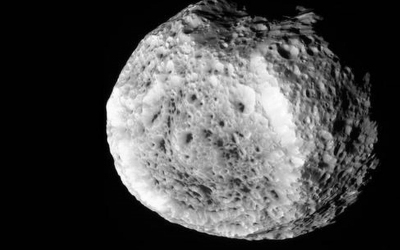
When we think about moons – natural satellites that orbit planets, dwarf planets and asteroids – the picture that we generally conceive is one of a spherical astronomical body that goes around another. This, perhaps, is due to our close association with Earth’s moon, as we see it wane and wax on a continuous basis. Moons, however, come in all shapes and sizes. Hyperion – one of Saturn’s satellites – is the largest such non-spherical moon among more than 200 moons that are in the solar system.
Hyperion was discovered in September 1848, both by English astronomer William Lassell and American astronomers, father-son duo William Cranch Bond and George Phillips Bond, independently of the other. While some accounts suggest that both the Englishman and the Americans made the discovery on September 19, others mention that they made the discovery days within each other around that time. What is certain, however, is that all three men are credited as the discoverers of Hyperion.
God of watchfulness
Hyperion’s discovery came at a time when English astronomer John Herschel had suggested that Saturn’s satellites be named after Titans from Greek Mythology. Hyperion, the name chosen for this moon of Saturn, corresponded to the Greek god of watchfulness and observation.
As a potato-shaped satellite, Hyperion differs from most others in that it isn’t spherical. This means that its shape is better described in terms of its diameter along its three axes and it works out to be 410 x 260 x 220 km. Scientists believe that its odd shape could be the result of a major impact on a large, spherical moon, and that Hyperion could be the remnant of that strike.
In resonance with Titan
Orbiting Saturn at a mean distance of 1.5 million km, it is one of Saturn’s few major moons that doesn’t have one face perpetually turned towards the planet, as it rotates chaotically. While it takes a little over 21 Earth days to orbit Saturn, it tumbles and spins unpredictably roughly every 13 Earth days.
The rotation is also influenced by Saturn’s largest moon, Titan. Titan, which orbits Saturn at a mean distance of 1.22 million km, goes around Saturn four times for every three of Hyperion. This puts their orbits in a dynamic 4:3 resonance, making the two moons zip faster and slower as they move past each other. As Titan is a much more massive body, its gravitational tugs considerably alter Hyperion’s orbit and rotation, adding to its eccentricity.
Heavily cratered
Even though Hyperion’s exact composition is still a mystery, it is known that it is slightly more than half as dense as water. Water ice with gaps, or porosity, as well as frozen methane or carbon dioxide could make up Hyperion. Such a make-up would make Hyperion akin to a large rubble pile, consistent with the idea of the satellite not having enough gravity to compact the smaller ice and rock bodies drawn together.
Hyperion’s sponge-like appearance stems from its heavily cratered surface. While these craters are deep, they do not show significant signs of rays of ejecta, resulting in its rather unique look. There are theories that the moon’s low density, coupled with high porosity, would crater more by compression, as opposed to the usual excavation.
The Cassini-Huygens mission saw the Cassini spacecraft make a number of flybys of Hyperion for over a decade, starting in 2004. The mission helped scientists realise that the satellite does build up static charge like the Earth’s moon, as Cassini passed through a beam of electrons coming from the moon’s surface. While the mission enabled us to see the satellite in more stunning detail than ever before, there is still plenty to know and learn about this tumbling, sponge-like moon.
Picture Credit : Google



